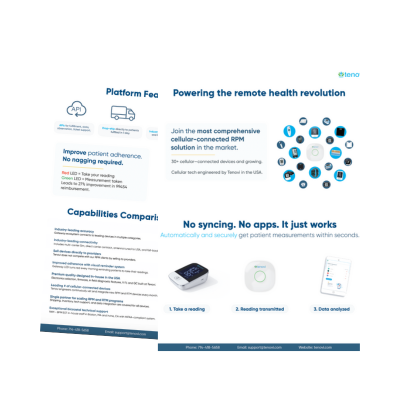Medical devices for Parkinson’s disease are no longer limited to in-clinic assessments or episodic data collection. With the growing use of remote therapeutic monitoring (RTM), clinicians now have access to continuous, real-time insights into a patient’s condition right from their home. This shift is transforming how Parkinson’s is managed, making care more personalized, data-driven, and scalable.
This article explores how medical devices for Parkinson’s disease are used in RTM, the leading tools on the market, and how healthcare professionals are incorporating these technologies to improve patient outcomes and streamline care.
Remote Monitoring for Parkinson’s Disease
Parkinson’s disease is a progressive neurological disorder characterized by motor symptoms such as tremor, rigidity, and bradykinesia, and non-motor symptoms, such as sleep disturbances and mood changes. The symptoms can begin slowly and do worsen over time. These symptoms can fluctuate not just daily, but hourly, something traditional care models, based on occasional in-person visits could miss.
Clinicians can monitor symptom patterns, medication adherence, and response to treatment outside of the clinic. This data provides a clearer and consistent view of the patient’s day-to-day reality. While some medical devices for Parkinson’s disease are still under development, others are currently available to clinicians to capture Parkinson’s disease symptom fluctuations in real-time.
Medical Devices for Parkinson’s Disease
Medical devices that qualify to be used for remote therapeutic monitoring include musculoskeletal activity trackers, motion trackers, inhaler usage trackers, medication adherence tracking devices, and respiratory monitoring devices. The following medical devices for Parkinson’s disease may support RTM by providing continuous, actionable data for clinical decision-making:
1. QDG-CARE with KeyDuo
This is a Bluetooth-enabled handheld, portable device under development with which patients perform a short tapping task. It captures metrics like tap frequency, tremor amplitude, and release speed to detect bradykinesia and rigidity. Integrated with EHRs, this medical device for Parkinson’s disease supports treatment adjustments based on objective symptom tracking.
The QDG-Care platform, featuring the KeyDuo device, has shown promise in clinical studies for remote monitoring of Parkinson’s disease symptoms. However, there is no publicly available information confirming its widespread commercial availability.
2. PDMonitor®
This multi-sensor wearable system continuously tracks motor and non-motor symptoms throughout the day. Medical professionals use this device to monitor treatment response remotely and fine-tune medication regimens for Parkinson’s patients.
3. Personal KinetiGraph (PKG)
A wrist-worn medical device for Parkinson’s disease that captures tremor, dyskinesia, and bradykinesia continuously. It helps clinicians adjust levodopa dosing with greater accuracy. While early studies show promise, further research is needed to confirm long-term effectiveness and cost benefits.
4. Kinesia 360 & KinesiaU
This system includes wearable motion sensors and a mobile app to monitor tremors and motor fluctuations. It provides feedback for clinicians and encourages self-management for patients. Though promising, more validation is needed for widespread adoption.
5. STAT-ON
A waist-worn medical device for Parkinson’s disease that detects gait freezing, falls, and activity patterns. Designed to track ON/OFF fluctuations, it’s a non-invasive tool for monitoring disease progression. While useful in care planning, current clinical impact evidence is still emerging.
How Healthcare Providers Use Medical Devices for Parkinson’s Disease
Remote therapeutic monitoring with medical devices for Parkinson’s disease is helping clinicians and care teams detect symptom changes early to avoid treatment delays. Clinicians can adjust medication based on real-time data, not just patient recall.
Additionally, remote monitoring is expanding virtual care access for patients in rural or mobility-restricted settings. Coordination can also be improved across providers who can use a shared data platform. For example, a neurologist might review KeyDuo results before a patient visit to refine a treatment plan. Or a clinical care manager could monitor PDMonitor data and schedule a check-in if new symptoms arise.
Health Systems and Value-Based Care
RTM-enabled medical devices for Parkinson’s disease are playing a key role in value-based care strategies. By offering real-time monitoring and evidence of treatment effectiveness, healthcare organizations can:
- Demonstrate measurable outcomes to payers
- Improve adherence to clinical guidelines
- Reduce unnecessary hospital visits and ER utilization
As reimbursement pathways for RTM expand, the use of medical devices for Parkinson’s disease is likely to become a standard of care, not just a supplement.
Understanding Medical Devices for Parkinson’s Disease
Medical devices for Parkinson’s disease are redefining how care is delivered. By bringing symptom monitoring into the patient’s daily environment, these tools offer a smarter, more proactive approach to treatment. Clinicians who adopt RTM not just as tech, but as an extension of clinical care, will be better positioned to deliver consistent, high-quality outcomes.
As technology and research continue to evolve, the future of Parkinson’s care is meeting the patient where they are.


